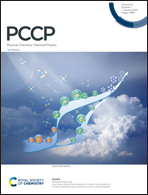A density functional theory study of a water gas shift reaction on Ag(111): potassium effect†
Abstract
Density functional theory (DFT) calculations are executed to investigate the effect of a potassium (K) promoter on the activity of the water gas shift reaction (WGSR) over an Ag(111) surface. It is found that the WGSR proceeds mainly through the OH(O)-assisted carboxy pathway in which H2O dehydrogenation is the rate-controlling step on both Ag(111) and K/Ag(111) surfaces. Energetic span model analysis shows that K addition can enhance the activity of the WGSR by reducing the apparent activation energy of the whole reaction since it can promote H2O dissociation and stabilize the adsorption of the reactants (CO and H2O). Importantly, the K adatom can stabilize the binding of all oxygenates by direct K–O bonding and the stabilizing effect of K on OH adsorption of the transition state (TS) plays a leading role in promoting H2O dissociation. Moreover, the K–O distance and K coverage are two key factors affecting H2O activation, that is, the shorter the K–O distance (2–3 Å) the more the K coverage (25%) contributes to the stronger promotion effect. For various metals catalyzing the WGSR, K promotes H2O dissociation on inert metals like Ag, Au and Cu better than those on reactive metals (Pd and Ni) since the more inert metal surfaces would weaken the K and O binding and accordingly strengthen the interaction between them, resulting in a higher promotion effect.



 Please wait while we load your content...
Please wait while we load your content...